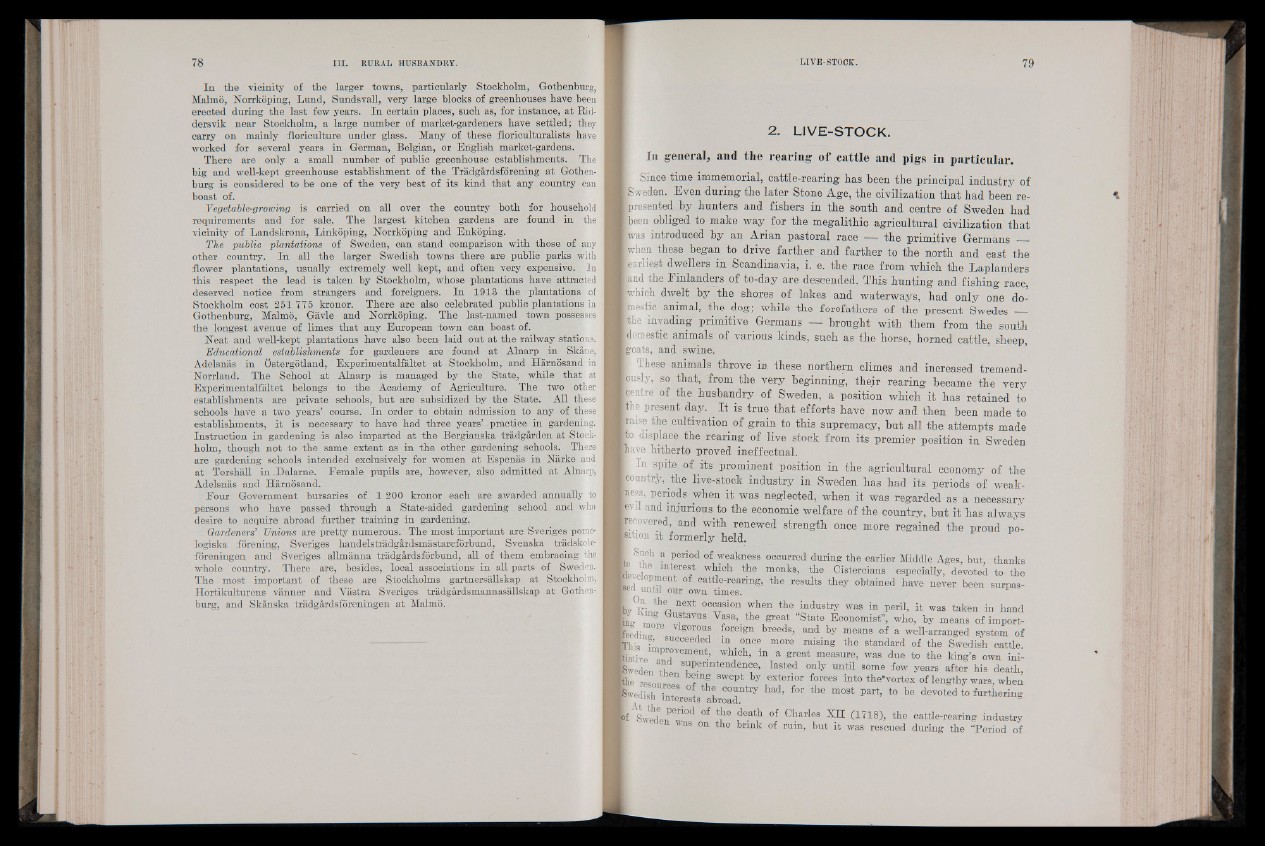
In the 'vicinity of the larger towns, particularly Stockholm, Gothenburg,
Malmo, Norrkoping, Lund, Sundsvall, very large blocks of greenhouses have been
erected during the last few years. In certain places, such as, for instance, at Rid-
dersvik near Stockholm, a large number of market-gardeners have settled; they
carry on mainly floriculture under glass. Many of these floriculturalists have
worked for several years in German, Belgian, or English market-gardens.
There are only a small number of public greenhouse establishments. The
big and well-kept greenhouse establishment of the Tràdgârdsforéning at Gothenburg
is considered to be one of the very best of its kind that any country can
boast of.
Vegetable-growing is carried on all over the country both for household
requirements and for sale. The largest kitchen gardens are found in the
vicinity of Landskrona, Linköping, Norrkoping and Enkoping.
The public plantations of Sweden, can stand comparison with those of any
other country. In all the larger Swedish towns there are public parks with
flower plantations, usually extremely well kept, and often very expensive. In
this respect the lead is taken by Stockholm, whose plantations have attracted
deserved notice from strangers and foreigners. In 1913 the plantations of
Stockholm cost 251 775 kronor. There are also celebrated public plantations in
Gothenburg, Malmo, Gavle and Norrkoping. The last-named town possesses
the longest avenue of limes that any European town can boast of.
Neat and well-kept plantations have also been laid out at the railway stations.
Educational establishments for gardeners are found at Alnarp in Skâne,
Adelsnâs in OstergotLand, Experimentalfaltet at Stockholm, and Hamosand in
Norrland. The School at Alnarp is managed by the State, whjle that at
Experimentalfaltet belongs to the Academy of Agriculture. The two other
establishments are private schools, but are subsidized by the State! All these
schools have a two years’ course. In order to obtain admission to any of these
establishments, it is necessary to have had three years’ practice in gardening.
Instruction in gardening is also imparted at the Bergianska trâdgârden at Stockholm,
though not to the same extent as in the other gardening schools. There
are gardening schools intended exclusively for women at Espenas in Nârke and
at Torshall in .Dalame. Female pupils are, however, also admitted at Alnarp,
Adelsnâs and Hamosand.
Four Government bursaries of 1 200 kronor each are awarded annually to
persons who have passed through a State-aided gardening' schooMand who
desire to acquire abroad further training in gardening.
Gardeners’ Unions are pretty numerous. The most important are Sveriges pomo-
logiska forening, Sveriges handelstrâdgârdsmâstareforbumd, Svepska trâdskole-
fôreningen and Sveriges allmânna trâdgârdsforbund, all of them embracing the
whole country. There are, besides, local associations in all parts of Sweden.
The most important of these are Stockholms gartnersâllskap at Stockholm,
Hortikulturens vanner and Vâstra Sveriges trâdgârdsmannasâllskap at Gothenburg,
and Skânska trâdgârdsforeningen at Malmo.
2. LIVE-STOCK.
In general, and the rearing of cattle and pigs in particular.
' Since time immemorial, cattle-rearing has been the principal industry of
(Sweden. Even during the later Stone Age, the civilization that had been represented
by hunters and fishers in the south and centre of Sweden had
(been obliged to make way for the megalithic agricultural civilization that
(was introduced by an Arian pastoral race — the primitive Germans -_
¡when these began to drive farther and farther to the north and east the
«earliest dwellers in Scandinavia, i. e. the race from which the Laplanders
ianid the Finlanders of to-day are descended. This hunting and fishing race,
¡which dwelt by the shores of lakes and waterways, had only one do-
gnestic animal, the dog; while the forefathers of the present Swedes —
[the invading primitive Germans — brought with them from the south
I domestic animals of various kinds, such as the horse, horned cattle, sheep,
■goats, and swine.
These animals throve in these northern climes and increased tremendously,
so that, from the very beginning, their rearing became the very
|entre of the husbandry of Sweden, a position which it has retained to
■he present day. ^ It is true that efforts have now and then been made to
raise the cultivation of grain to this supremacy, but all the attempts made
lo displace the rearing of live stock from its premier position in Sweden
have hitherto proved ineffectual.
I In spite of its prominent position in the agricultural economy of the
•country, the live-stock industry in Sweden has had its periods of weakness,
periods when it was neglected, when it was regarded as a necessary
ftvil and injurious to the economic welfare of the country, but it has always
Recovered, and with renewed strength once more regained the proud po-
Isitioii it formerly held.
I Such a period of weakness occurred during the earlier Middle Ages, but, thanks
EevPlmmlntf ef H I H monks’ the Cistercians especially, devoted to the
of eattle-reamig, the results they obtained have never been surpas-
| ' ea mrtu our own: times.
lb y ° iL lh p ^ B 8 9 fb e n tlle industry was in peril, it was taken in hand
■nc m ustavus Vasa) ibe great “State Economist”, who, by means of import-
■Sedinff foreiSn breeds> “ d by means of a well-arranged system of
■ h i f ’ suoceeded . m 1 once more raising the standard of the Swedish cattle,
iiativp provemf nti which, m a great measure, was due to the king’s own ini-
■Sweden H .ermtendence, lasted only until some few years after his death,
|b e resound H i SW8Pt by ^ erior forces mto the*vortex of lengthy wars, when
Iw e d is h lt e r e it s 1Abroad ’ ^ t0 ^ deTOted to furthering
I f N i/e.atb °barles XH (1718), the cattle-rearing industry
was on the brink of ruin, but it was rescued during the “Period of